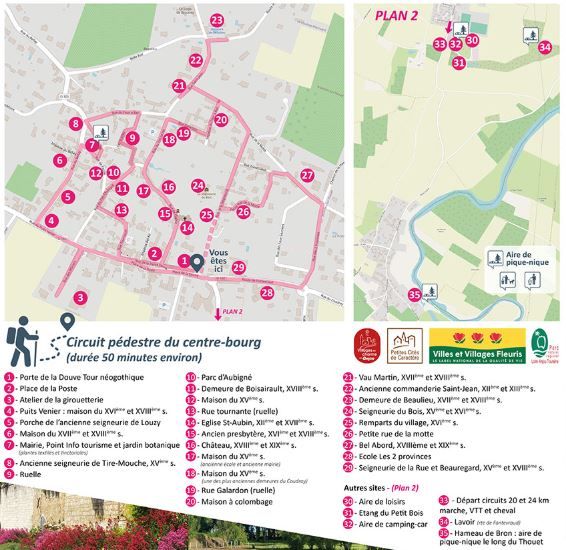
Circuit pédestre du centre-bourg (50 min)
Bienvenue au Coudray-Macouard !
Situé au cœur du Val de Loire et du Parc Naturel Régional Loire-Anjou-Touraine et labellisé « Village de charme en Anjou », « Petites Cités de Caractère » et « Villes et Villages Fleuris », Le Coudray-Macouard jouit d’un patrimoine botanique et architectural remarquable. Il est également surnommé « Le village aux 1000 girouettes ».
Un peu d’histoire …
Le nom de la commune aurait une origine botanique car le Coudray viendrait de "coudrier" qui veut dire noisetier. A ce nom est joint le nom du Seigneur Macouard vers la fin du XIème siècle.
En 1147, Geoffroy Plantagenêt, Comte d’Anjou et père du roi Henri VI d’Angleterre, fait édifier au sommet de la butte un château fort destiné à surveiller le (espace en trop) Seigneur de Montreuil-Bellay, Giraut Berlay. Du château, il ne reste que la chapelle devenue église paroissiale St Aubin ainsi que la partie Est des remparts.
Situé sur une butte de calcaire tendre, le Coudray-Macouard est truffé de caves souterraines troglodytiques qui ont servi de refuges, de lieu de stockage du vin, d’habitation ou d’extraction de la pierre de tuffeau ayant servi à la construction de monuments et de maisons d’habitation. Les caves ont également fait office de lieu de contrebande de sel au temps de la gabelle en raison de la situation géographique du village dans la région de l’Anjou mais en limite du Poitou.
A la découverte du village
Nous vous invitons à découvrir le village en suivant le parcours proposé ou bien tout simplement à flâner au gré de vos envies et vous perdre dans les rues et ruelles fleuries de notre magnifique village.
Laissez-vous émerveiller par le charme de son fleurissement champêtre avec ses plantes textiles et tinctoriales mais également par ses belles demeures datant du XVème, XVIème, XVIIème et XVIIIème siècles.
Enfin, pensez à lever les yeux pour découvrir les nombreuses girouettes qui ornent les toits du village.
Bonne balade !
Traduction
Welcome to Coudray-Macouard!
Located at the heart of the Val-de-Loire region and the Loire-Anjou-Touraine Regional Nature Park, certified “Charming Village in Anjou”, “Small Town of Character” and “City and Villages in Bloom”, Le Coudray-Macouard enjoys a remarkable botanical and architectural heritage. It is also nicknamed “The Village with 1000 Weathervanes”.
A bit of history…
The name of the town is said to have a botanical origin. Coudray comes from the French “coudrier”, which means hazel tree. The name of the lord Macouard was added to it by the end of the 11th century.
In 1147, the earl of Anjou, Geoffroy Plantagenêt, had a fortified castle built at the top of the hillock, with aim to watch over the lord of Montreuil-Bellay, Giraut Berlay. Of the castle, only the old chapel which became the St Aubin parish church and the eastern part of the fortifications are left.
Located on a soft limestone hillock, Le Coudray-Macouard is teeming with underground troglodytic cellars which were used as shelters, wine storage, housing, and for the quarrying of the tuffeau stone, used for the construction of monuments and houses. Due to the location of the town, between the two regions of Poitou and Anjou, the cellars also served as a place for smuggling salt during the time of the salt tax.
Discovering the village
We kindly invite you to discover the village by following the suggested route or by simply strolling according to your whims and wander in the flowery streets and alleys of our magnificent village.
Let yourself be amazed by the charm of its bucolic blossoming, with fibre plants and tinctorial (dyeing) plants, but also admire its beautiful dwellings dating back to the 15th, 16th and 17th centuries.
And of course, do not forget to look up to discover the numerous weathervanes that adorn the roofs of the village.
Have a nice walk!

Cordonnées de la mairie
Adresse : Rue de Pazille,
49260, Le Coudray-Macouard
Téléphone : +33 2.41.67.98.10
Email :
Horaires de la mairie
Lundi au Vendredi : 8h-12h30/13h30-18h
Sauf le mercredi : 8h30-12h30